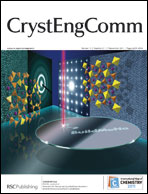{Co(HBpe)2}(V4O12): pedal motion induced order–disorder P![[1 with combining macron]](https://www.rsc.org/images/entities/char_0031_0304.gif) → C
→ C![[1 with combining macron]](https://www.rsc.org/images/entities/char_0031_0304.gif) transition and disrupted C
transition and disrupted C![[1 with combining macron]](https://www.rsc.org/images/entities/char_0031_0304.gif) → C2/m displacive transition due to thermal instability†
→ C2/m displacive transition due to thermal instability†
Abstract
The one dimensional {Co(HBpe)2}(V4O12) inorganic–organic compound, where ![[1 with combining macron]](https://www.rsc.org/images/entities/char_0031_0304.gif) , with a = 15.4705(3) Å, b = 11.8919(3) Å, c = 7.8490(2) Å, α = 88.252(2)°, β = 95.429(2)° and γ = 92.534(2)° at 100 K. The crystal structure possesses two crystallographically independent units, strong pseudo-symmetry elements, and a unit cell with a possible monoclinic metric at higher temperatures. At low temperature (100–293 K) the crystallographically independent units present perfectly ordered conformers of the HBpe
, with a = 15.4705(3) Å, b = 11.8919(3) Å, c = 7.8490(2) Å, α = 88.252(2)°, β = 95.429(2)° and γ = 92.534(2)° at 100 K. The crystal structure possesses two crystallographically independent units, strong pseudo-symmetry elements, and a unit cell with a possible monoclinic metric at higher temperatures. At low temperature (100–293 K) the crystallographically independent units present perfectly ordered conformers of the HBpe ![[1 with combining macron]](https://www.rsc.org/images/entities/char_0031_0304.gif) to C
to C![[1 with combining macron]](https://www.rsc.org/images/entities/char_0031_0304.gif) order–disorder structural transition. At higher temperatures the crystal structure tends to the monoclinic C2/m symmetric crystal structure, however, the thermal instability disrupts this hypothetical displacive structural transition. To the best of our knowledge this is the second polymeric compound in which the pedal motion has been reported. The spectroscopic and magnetic properties were also determined. The IR-spectrum shows the characteristic bands related to the organic
order–disorder structural transition. At higher temperatures the crystal structure tends to the monoclinic C2/m symmetric crystal structure, however, the thermal instability disrupts this hypothetical displacive structural transition. To the best of our knowledge this is the second polymeric compound in which the pedal motion has been reported. The spectroscopic and magnetic properties were also determined. The IR-spectrum shows the characteristic bands related to the organic
![Graphical abstract: {Co(HBpe)2}(V4O12): pedal motion induced order–disorder P [[1 with combining macron]] → C [[1 with combining macron]] transition and disrupted C [[1 with combining macron]] → C2/m displacive transition due to thermal instability](/en/Image/Get?imageInfo.ImageType=GA&imageInfo.ImageIdentifier.ManuscriptID=C1CE05418J&imageInfo.ImageIdentifier.Year=2011)

 Please wait while we load your content...
Please wait while we load your content...
![[1 with combining macron]](https://www.rsc.org/images/entities/h2_char_0031_0304.gif) → C
→ C